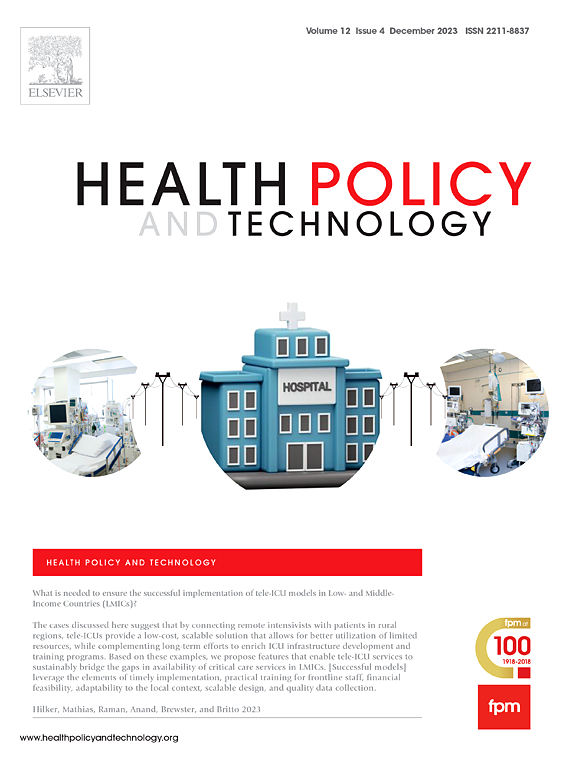Enhancing in-hospital cardiac arrest outcomes through the Tele-ICU Model: A novel approach to CPR quality improvement in India
IF 3.7
3区 医学
Q1 HEALTH POLICY & SERVICES
引用次数: 0
Abstract
Introduction
In-hospital cardiac arrest is a substantial cause of morbidity and mortality in low- and middle-income countries. Telemedicine intensive care units (Tele-ICUs) may expand critical care capacity, however their impact on cardiac arrest management and outcomes has not been well-defined.
Methods
A tele-ICU network established in India provides 24/7 multidisciplinary monitoring and management via real-time audiovisual technology. Between September 2022-November 2023, six partner hospitals underwent tele-ICU implementation and participated in a spaced advanced cardiac life support (ACLS) curriculum, tailored to tele-ICU workflows. The study period spanned from three months prior to the bedside ACLS training (“pre-intervention”) to six months following completion (“post-intervention”). The impact of the intervention on return of spontaneous circulation (ROSC) rates and overall hospital mortality was assessed with multivariable logistic regression and interrupted time series analysis.
Results
Among a total of 163 cardiac arrest events (n = 52 pre-intervention, n = 111 pre-intervention), most took place within 5 days of ICU admission (83.4 %) and asystole (61.3 %) was the most common precipitating rhythm. Tele-ICU sites achieved significantly greater ROSC rates during the post-intervention (38.7 %) versus the pre-intervention (19.2 %) periods (adjusted odds ratio [aOR] 3.65 [95 % confidence interval [CI] 1.40–9.53]). This corresponded with an immediate 16.1 % (95 % CI 0.7 %-31.5 %) level increase without a significant trend change (-0.10 % [-0.97 %-0.77 %]). Overall hospital survival remained similar (4.5 % vs. 3.8 %; aOR 0.69 [95 % CI 0.08–5.72]) between study periods.
Conclusions
Tele-ICU implementation coupled with targeted ACLS training was associated with improvements in immediate in-hospital cardiac arrest outcomes, highlighting the potential of low-cost, technology-enabled care delivery models to optimize resuscitation performance in LMICs.
通过远程icu模式提高院内心脏骤停结果:印度CPR质量改善的新方法
医院内心脏骤停是低收入和中等收入国家发病率和死亡率的一个重要原因。远程医疗重症监护病房(tele - icu)可以扩大重症监护能力,但其对心脏骤停管理和结果的影响尚未明确。方法在印度建立远程icu网络,通过实时视听技术提供全天候多学科监测和管理。在2022年9月至2023年11月期间,6家合作医院实施了远程icu,并参加了针对远程icu工作流程量身定制的间隔高级心脏生命支持(ACLS)课程。研究期间从床边ACLS培训前的三个月(“干预前”)到完成后的六个月(“干预后”)。采用多变量logistic回归和中断时间序列分析评估干预对自发循环恢复(ROSC)率和总体医院死亡率的影响。结果163例心脏骤停事件(干预前52例,干预前111例)中,发生在ICU入院5 d内的发生率最高(83.4%),最常见的诱发心律为骤停(61.3%)。与干预前(19.2%)相比,远程icu站点在干预后的ROSC率(38.7%)显著更高(调整优势比[aOR] 3.65[95%可信区间[CI] 1.40-9.53])。这相当于立即增加16.1% (95% CI 0.7% - 31.5%)的水平,而没有显著的趋势变化(- 0.10%[- 0.97% - 0.77%])。总体住院生存率相似(4.5% vs. 3.8%;(aOR 0.69 [95% CI 0.08-5.72])。结论:采用steli - icu配合有针对性的ACLS培训与院内即时心脏骤停结果的改善相关,突出了低成本、技术支持的护理交付模式在优化中低收入国家复苏表现方面的潜力。
本文章由计算机程序翻译,如有差异,请以英文原文为准。
求助全文
约1分钟内获得全文
求助全文
来源期刊

Health Policy and Technology
Medicine-Health Policy
CiteScore
9.20
自引率
3.30%
发文量
78
审稿时长
88 days
期刊介绍:
Health Policy and Technology (HPT), is the official journal of the Fellowship of Postgraduate Medicine (FPM), a cross-disciplinary journal, which focuses on past, present and future health policy and the role of technology in clinical and non-clinical national and international health environments.
HPT provides a further excellent way for the FPM to continue to make important national and international contributions to development of policy and practice within medicine and related disciplines. The aim of HPT is to publish relevant, timely and accessible articles and commentaries to support policy-makers, health professionals, health technology providers, patient groups and academia interested in health policy and technology.
Topics covered by HPT will include:
- Health technology, including drug discovery, diagnostics, medicines, devices, therapeutic delivery and eHealth systems
- Cross-national comparisons on health policy using evidence-based approaches
- National studies on health policy to determine the outcomes of technology-driven initiatives
- Cross-border eHealth including health tourism
- The digital divide in mobility, access and affordability of healthcare
- Health technology assessment (HTA) methods and tools for evaluating the effectiveness of clinical and non-clinical health technologies
- Health and eHealth indicators and benchmarks (measure/metrics) for understanding the adoption and diffusion of health technologies
- Health and eHealth models and frameworks to support policy-makers and other stakeholders in decision-making
- Stakeholder engagement with health technologies (clinical and patient/citizen buy-in)
- Regulation and health economics
 求助内容:
求助内容: 应助结果提醒方式:
应助结果提醒方式:


